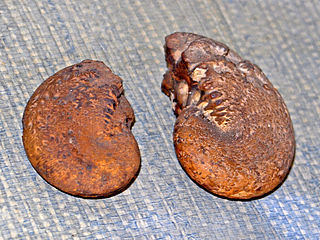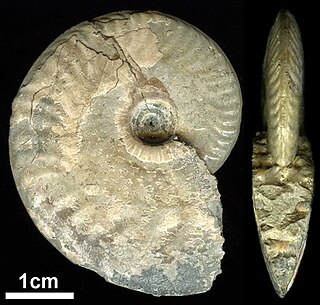
Ammonitida is an order of more highly evolved ammonoid cephalopods that lived from the Jurassic through Cretaceous time periods, commonly with intricate ammonitic sutures.
In the geologic timescale the Bathonian is an age and stage of the Middle Jurassic. It lasted from approximately 168.3 Ma to around 166.1 Ma. The Bathonian age succeeds the Bajocian age and precedes the Callovian age.
The Phyllocertina comprise a suborder of ammonoid cephalopods, belonging to the Ammonitida, whose range extends from the Lower Triassic to the Upper Cretaceous. Shells of the Phylloceratina are generally smooth with small to large umbilici and complex sutures with leaf-like phylloid saddle endings and lobes with thorn-like projections.

Aulacostephanus is an extinct ammonoid cephalopod genus from the Upper Jurassic Tithonian belonging to the perisphinctacean family Aulacostephanidae.

Lytoceratina is a suborder of Jurassic and Cretaceous ammonites that produced loosely coiled, evolute and gyroconic shells in which the sutural element are said to have complex moss-like endings.

Ammonitina comprises a diverse suborder of ammonite cephalopods that lived during the Jurassic and Cretaceous periods of the Mesozoic Era. They are excellent index fossils, and it is often possible to link the rock layer in which they are found to specific geological time periods.
Haploceratoidea, formerly Haplocerataceae, is a superfamily of ammonoid cephalopods belonging to the Ammonitida that unites three families, Strigoceratidae, Oppeliidae, and Haploceratidae, listed below.

Stephanoceratoidea, formerly Stephanocerataceae, is a superfamily of middle- upper Jurassic ammonoid cephalopods within the order Ammonitida containing diverse forms, generally with sharp ribbing and complex suture lines. Aptychi are believed to be mostly granular (Granulaptycus) or concentrially ribbed on the surface (Praestriaptychus)

Phylloceratidae is the predominant family of the Phylloceratina with some 15 or more genera found in rocks ranging from the Lower Jurassic to the Upper Cretaceous. Members of the Phylloceratidae are characterized by smooth, involute shells with very thin walls. Many are covered with fine growth lines but are usually without ribbing. Sutures are complex with the major and minor branches of the saddles with phylloid or spatulate endings.
Otoidtidae: stephanoceratoid ammonitina from the early Middle Jurassic that begin as cadicones but become more planualte with age; derived from the Hammitoceratidae (Hildoceratoidea), probably through Erycites by way of Abbasites.

Hildoceratoidea, formerly Hildoceratacaea, is a superfamily of compressed or planulate ammonites, some tending to develop acute outer rims; generally with arcuate or sigmoidal ribs. Aptichus were found in place are double-valved.

Perisphinctoidea, formerly Perisphinctaceae, is a superfamily of Middle Jurassic (Bajocian) to Lower Cretaceous (Barremian) ammonites, commonly with evolute shells with strong ribbing that typically divides about mid flank before crossing the venter.
Pachyceratidae is a family of Perisphinctoidean ammonites from the upper Middle - and lower Upper Jurassic. Genera within the Pachyceratidae have shells that are in general moderately involte but with most of the inner whorls exposed; whorl sections subquadrate to subtrapezoidal, with rounded venter. Ribbing is strong, in some sharp. Primary ribs typically branch above mid flanks into twos, threes, and even fours.

Oppeliidae are compressed to oxyconic, sculptured Haploceratoidea, either unkeeled, unicarinate, bicarinate, or tricarinate; with sutures in great variety, but ribbing usually more or less falcoid or falcate. The Oppeliidae is the principal family of the Haploceratoidea, with the longest duration, extending from the Middle Jurassic (Bajocian) to the Upper Cretaceous (Cenomanian) Their derivation is from the Hildoceratoidea.
The Aspidoceratinae is a subfamily in the perisphictacean ammonite family, Aspidoceratidae found world wide in middle and upper Jurassic sediments.

Hildoceratidae is a family of ammonoid cephalopods from the Lower Jurassic, lower Pliensbachian to lower Bajocian substages, generally with strongly ribbed, involute shells. They are combined with the Hammatoceratidae, Graphoceratidae, and Sonniniidae to make up the Hildoceratoidea.

Perisphinctidae is a family of Middle and Upper Jurassic discoidal ammonites in the order Ammonitida. They have a shell morphology that is mostly evolute, typically with biplicate, simple, or triplicate ribbing. Large forms have simple apertures and smooth body chambers while small forms have lappets and ribbed body chambers.

The family Dactylioceratidae comprises Early Jurassic ammonite genera with ribbed and commonly tuberculate shells that resembled later Middle Jurassic stephanoceratids and Upper Jurassic perisphinctids. Shells may be either evolute or involute.
Oppeliinae is a subfamily within the Oppeliidae, a family of Jurassic ammonites characterized by forms that are mainly oxyconic, compressed with sharp venters, in the adult and with keeled inner whorls. Sutures are complex, consisting of a long series of evenly graded lobes and saddles with finely frilled endings.

Hammatoceratidae is a family of lower and middle Jurassic ammonites included in the superfamily Hildoceratoidea.











